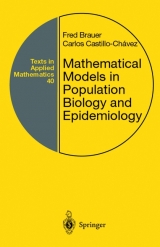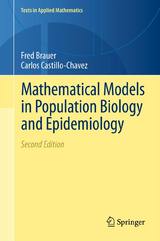Mathematical Models in Population Biology and Epidemiology
Seiten
2001
Springer-Verlag New York Inc.
978-0-387-98902-0 (ISBN)
Springer-Verlag New York Inc.
978-0-387-98902-0 (ISBN)
- Titel erscheint in neuer Auflage
- Artikel merken
Zu diesem Artikel existiert eine Nachauflage
Intends to seek balance between simple, analyzable models and unsolvable models able to address questions on population biology. This book covers single species simple models including those used to predict human and animal growth population in the past. It discusses realistic models key to the study of ecological and demographic processes.
The goal of this book is to search for a balance between simple and analyzable models and unsolvable models which are capable of addressing important questions on population biology. Part I focusses on single species simple models including those which have been used to predict the growth of human and animal population in the past. Single population models are, in some sense, the building blocks of more realistic models -- the subject of Part II. Their role is fundamental to the study of ecological and demographic processes including the role of population structure and spatial heterogeneity -- the subject of Part III. This book, which will include both examples and exercises, is of use to practitioners, graduate students, and scientists working in the field.
The goal of this book is to search for a balance between simple and analyzable models and unsolvable models which are capable of addressing important questions on population biology. Part I focusses on single species simple models including those which have been used to predict the growth of human and animal population in the past. Single population models are, in some sense, the building blocks of more realistic models -- the subject of Part II. Their role is fundamental to the study of ecological and demographic processes including the role of population structure and spatial heterogeneity -- the subject of Part III. This book, which will include both examples and exercises, is of use to practitioners, graduate students, and scientists working in the field.
Part I: Simple Single-Species Models. 1. Continuous population models. 2. Discrete population models. 3. Continuous single-species population models with delay.- Part II: Models for Interacting Species. 4. Introduction and mathematical preliminaries. 5. Continuous models for two interacting populations. 6. Harvesting in two-species population models. 7. Multi-species population models.- Part III: Structured Population Models. 8. Models for population with age structure. 9. Models for populations with spatial distribution.
| Reihe/Serie | Texts in Applied Mathematics ; Vol.40 |
|---|---|
| Zusatzinfo | 1, black & white illustrations |
| Verlagsort | New York, NY |
| Sprache | englisch |
| Maße | 156 x 234 mm |
| Gewicht | 802 g |
| Einbandart | gebunden |
| Themenwelt | Mathematik / Informatik ► Mathematik |
| Naturwissenschaften ► Biologie ► Evolution | |
| Naturwissenschaften ► Biologie ► Ökologie / Naturschutz | |
| Naturwissenschaften ► Physik / Astronomie | |
| ISBN-10 | 0-387-98902-1 / 0387989021 |
| ISBN-13 | 978-0-387-98902-0 / 9780387989020 |
| Zustand | Neuware |
| Haben Sie eine Frage zum Produkt? |
Mehr entdecken
aus dem Bereich
aus dem Bereich
Komplette Neuübersetzung. Mit einem Nachwort von Josef H. Reichholf.
Buch | Hardcover (2018)
Klett-Cotta (Verlag)
48,00 €
Wie die Vernichtung der Arten unser Überleben bedroht - Der …
Buch | Softcover (2023)
Penguin (Verlag)
15,00 €





